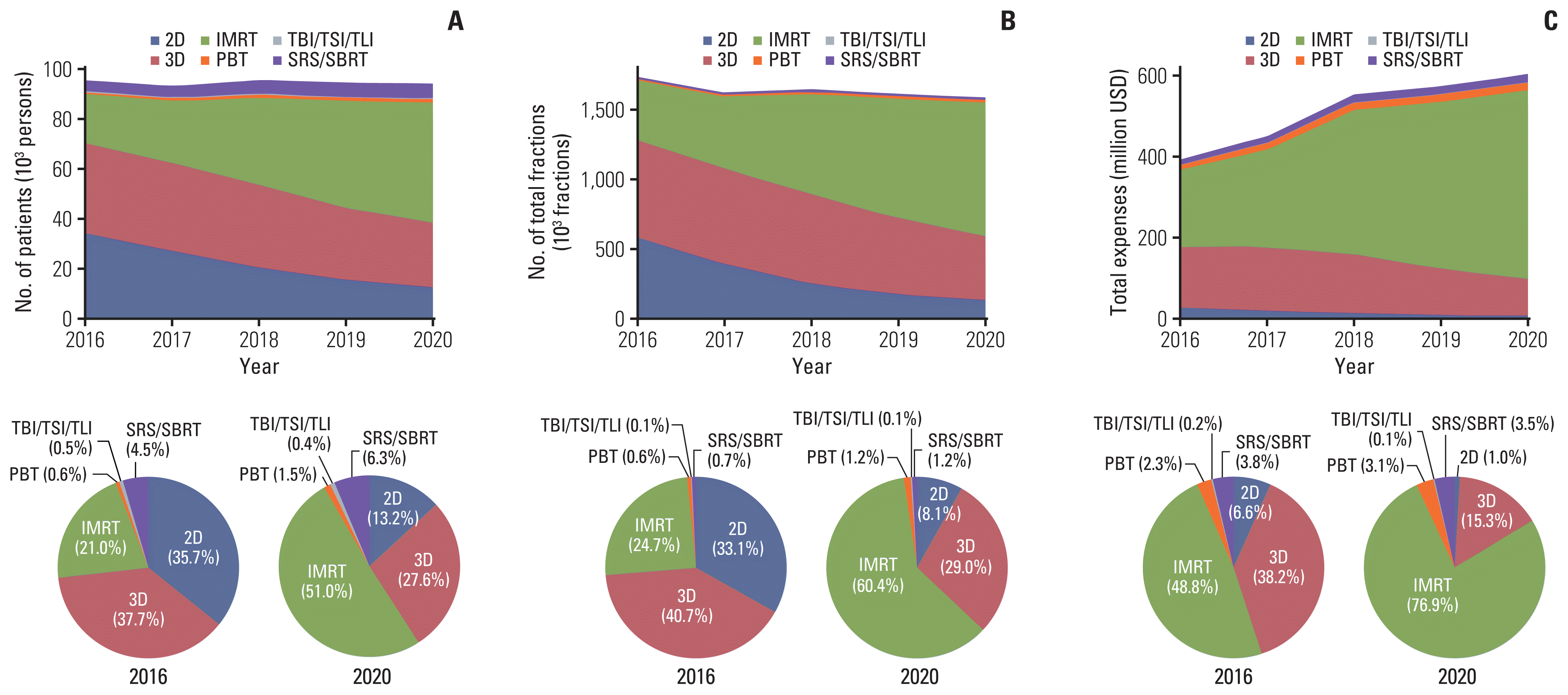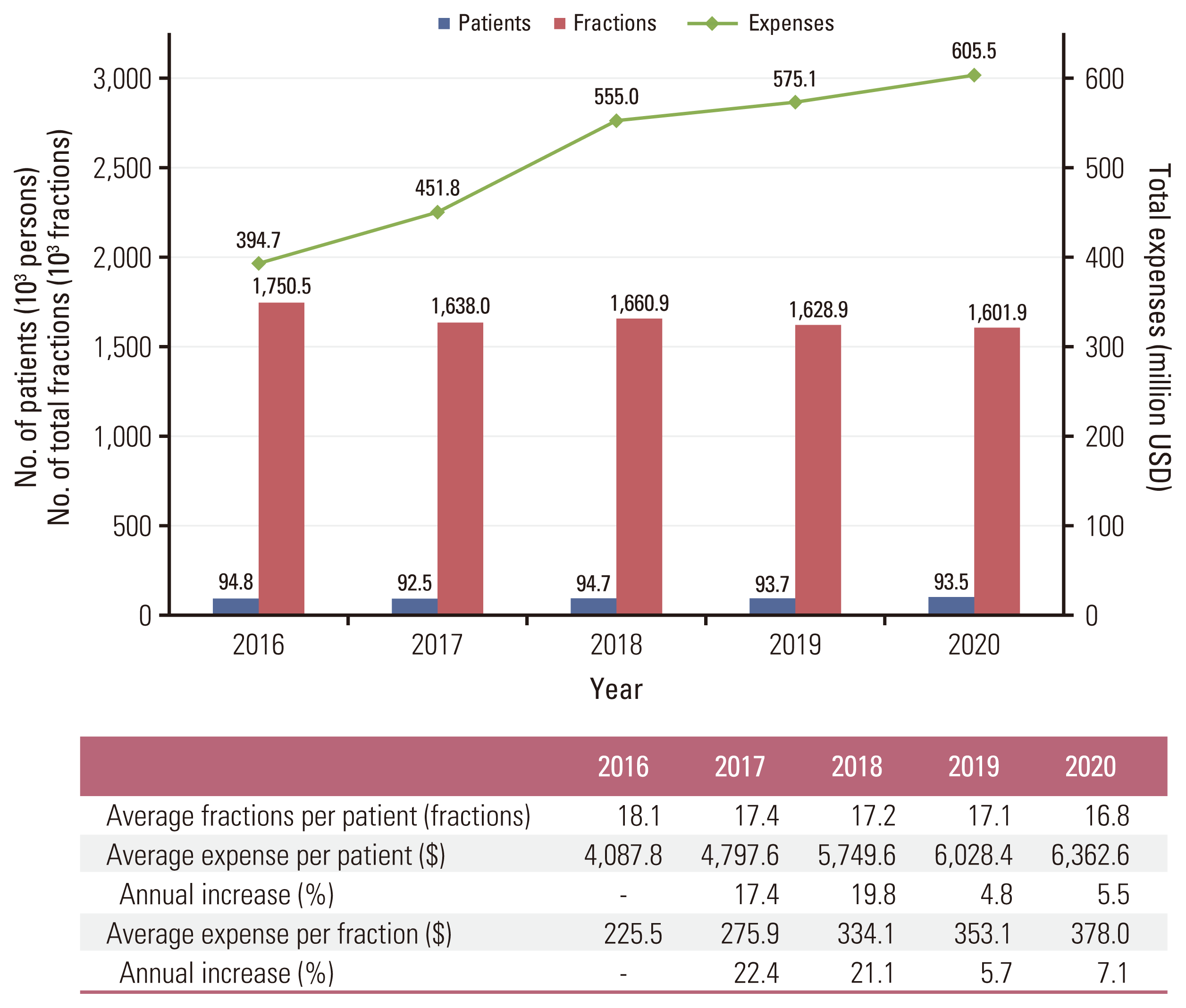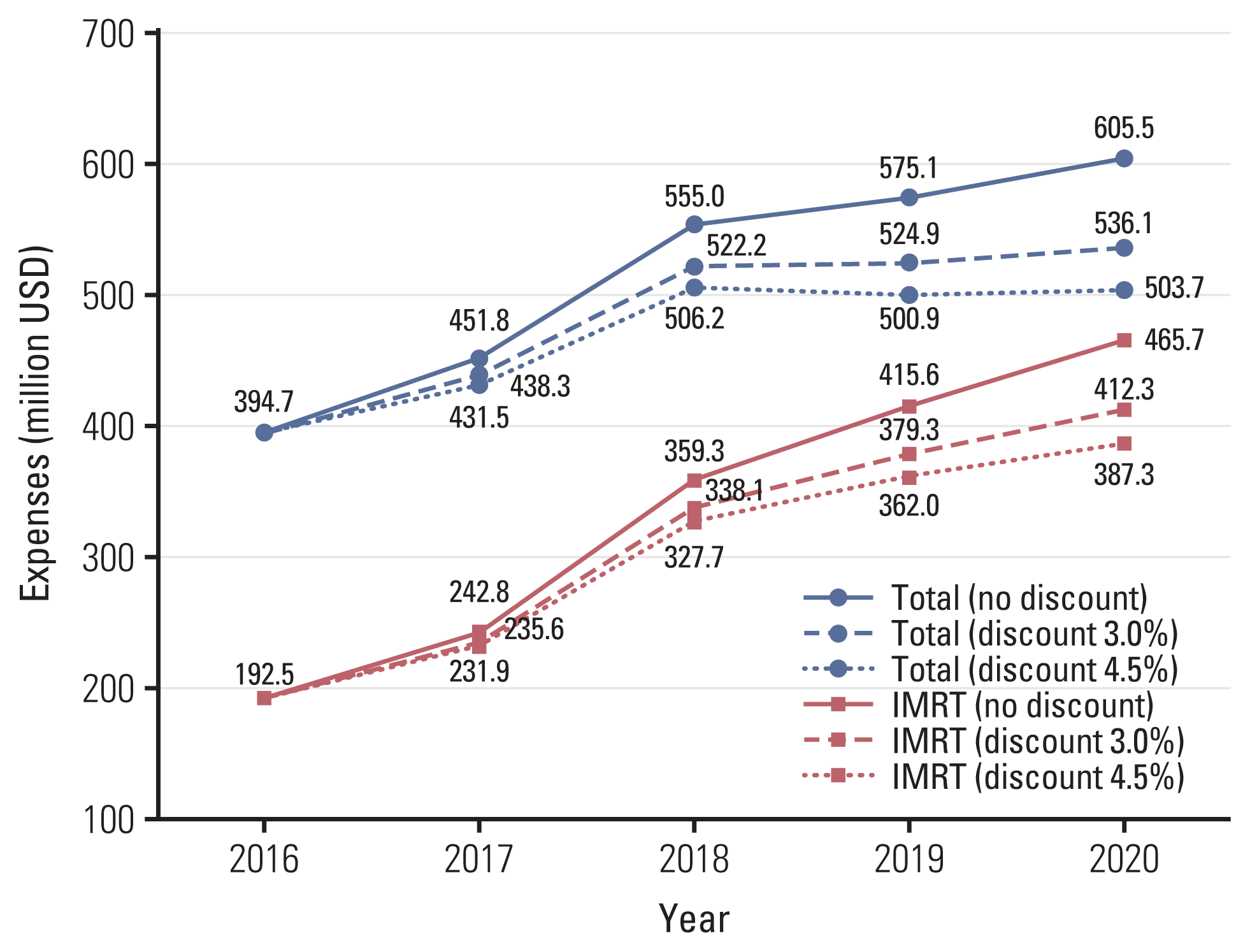Introduction
The incidence of cancers in South Korea continues to increase [
1]. As an important tool for cancer treatment, radio-therapy (RT) has been widely used for curative and palliative purposes [
2–
4]. In Korea, 36.1% of all patients with cancer were treated with RT in 2019 [
5]. Furthermore, recent technological advances in RT have been recognized after their successful use in the management of various types of cancers [
6,
7].
In 2007, growing manpower and infrastructure for RT were reported, although the size of the infrastructure compared to the size of the population was still insufficient [
8]. Furthermore, another study about the geographical distribution of RT in Korea revealed a process of centralization toward the metropolitan areas, which is different from the situation in Japan [
9]. In addition, it was reported that the use of intensity-modulated radiation therapy (IMRT) had increased 18 times in 2018 compared to that in 2011 [
10]. Studies have reflected rapid changes in the clinical use of RT and suggested the need for analysis and assessment of the increased expenses associated with advanced RT techniques, especially IMRT, which is commonly used for the management of breast cancers.
We, therefore, analyzed the total expenses associated with RT based on open data resources regarding the patterns of RT use from the National Health Insurance Service (NHIS) of South Korea.
Materials and Methods
We used information on claims and reimbursements records from the Health and Insurance Review and Assessment Service (HIRA) Big data based on the NHIS, which provided pre-processed statistics, including the annual number of patients receiving RT, usages or fractions, and the amount of total medical expenses according to treatment codes for RT, sex, age, and the geographical regions of hospitals (
http://opendata.hira.or.kr/op/opc/olapDiagBhvInfo.do). Total medical expenses include the amount paid by the insurer (NHIS) and patients. We analyzed the data from 2016 to 2020. Most data used in this study are available in the Excel file (
S1 Datafile). The review exemption of this study using the publicly available information was approved by the Institutional Review Board (SMC 2022-06-067).
We used the treatment and planning codes related to RT to gather the data (
S2 Table). The treatment codes were categorized as 2-dimensional radiotherapy (2D-RT), 3-dimensional conformal radiotherapy (3D-CRT), IMRT, proton beam therapy (PBT), techniques for hematologic malignancy including total body irradiation, total lymph node irradiation, total skin irradiation, and stereotactic radiosurgery (SRS; single fraction)/stereotactic body radiotherapy (SBRT; 2–4 fractions), which are the available RT types using linear accelerators (Linac), Tomotherapy (Tomo), Cyberknife, and PBT. Other machines using radioactive isotopes such as Gammaknife, brachytherapy, permanent implantation, and intra-operative RT were excluded. To calculate the total expenses for RT, we added the expenses for planning, which included simulation, as well as treatment. However, the planning codes (HD019 and HD419) for SRS/SBRT are shared with Linac, Cyberknife, and Gammaknife. Therefore, the expenses for planning were estimated excluding the number of patients associated with Gammaknife.
For international communication, the expenses in Korean Won were converted into U.S. dollars (USD) using the annual average exchange rate announced by the Bank of Korea (
https://ecos.bok.or.kr). Additional information such as the number of hospitals performing RT, radiation oncologists, and RT machines was obtained through the Korean Society for Radiation Therapy (
https://kosrt.krta.or.kr) and the Korean Statistical Information Service (
https://kosis.kr). Further, general data, such as age distribution in the population and prevalence and incidence of cancer in Korea were obtained from the national statistics (
http://kosis.kr).
To compare the present value of the annual total expense and the expense of IMRT, sensitivity analysis for the discount rates was performed. As of 2016, the discount rates of 0%, 3.0%, and 4.5% per year were used as per the guidelines for the Economic Evaluation of Pharmaceuticals in Korea (
https://repository.hira.or.kr/handle/2019.oak/2541).
Discussion
This is the first report of RT expenses in Korea using national insurance data. In Korea, over 98% of patients with cancer are registered in the national cancer registry system [
11], and approximately 95% of the costs for cancer treatment, including RT expenses, are supported by national insurance. This study yielded unclear results, as the total medical expenses included the medical expenses borne by the insurer (NHIS) and patients. Nevertheless, the expenses for cancer were fixed at approximately 5%. In addition, although this exemption calculation for patients with cancer is applicable only for 5 years from the diagnosis of cancer, no change in the co-payment rate is expected because the exemption calculation is re-applied if the cancer treatment, such as RT, is required again. Therefore, the results of this study are close to the insurer’s point of view.
We reviewed HIRA data with regard to RT from 2016 to 2020, focusing on its use and expense. The expenses for RT were over 600 million USD in 2020, having increased 1.5 times over 4 years in tandem with a growing RT infrastructure. The proportion of RT expenses in total insurance claims in Korea also increased from 0.62% in 2016 to 0.72% in 2020. This was mainly because of the increased usage of advanced techniques, especially IMRT. It is suggested that the following changes have affected RT clinics. Since 2015, the coverage of national insurance has been expanded to include advanced techniques for most types of solid tumors [
5]. Furthermore, given the evidence regarding the benefits of advanced techniques in the management of various tumors, these methods appear to have been rapidly applied in clinics [
10,
12]. Expenses for IMRT increased stiffly, constituting 76.9% of total RT expenses in 2020. Further, the sensitivity analysis of expenses showed that the total expenses with a 4.5% discount rate had been maintained at the same level since 2018; however, the IMRT expenses continue to increase (
Fig. 3). Expenses for RT have also increased recently in Japan, and the increase rate is similar to that in Korea [
13]. However, Korean IMRT use was higher compared to the 20%–30% increase in Japan [
13,
14].
Contrary to the increase in expenses, the number of patients has not changed, and the number of fractions has decreased over 4 years. Decreased fractions might be caused by recent clinical trends such as fewer fractionations including SBRT over traditional palliation and the protocol of hypofractionation in early breast cancer management [
4,
15]. However, despite the increase in infrastructure for RT and the total number of patients with cancer, the number of patients per radiation oncologist and machines has decreased continuously. The lack of detailed reasons provided for this phenomenon in this study is because advanced techniques generally need more time and resources per fraction when compared to those of 2D-RT and 3D-CRT, and this may limit the capacity of RT [
16]. Therefore, we could not conclude the current number of radiation oncologists and the RT infrastructure are sufficient since IMRT has been used universally. In 2020, the number of RT machines was 4.1 megavoltage machines per million in Korea, and it was still much lesser than that in Japan, which is approximately 8–9 per million [
9]. Furthermore, the total RT equipment, including machines using megavoltage X-rays or radionuclides, is lesser in Korea than that in other developed countries. In 2019 or 2020, there were 6.1, 8.1, 11.5, and 19.1 per million inhabitants in Korea, the United Kingdom, the United States, and Switzerland, respectively [
17]. Therefore, we suggest that Korea has the potential to increase the number of RT machines. Most new RT machines can use the IMRT technique, and its usage is expected to increase further owing to the greater utilization of advanced techniques.
Regarding characteristics, the proportion of older individuals was high and increased gradually (
Fig. 4). This may be caused by the aging of the population and longer life expectancy [
1]. From 2016 to 2020, the population of individuals aged over 65 years increased by 21.5 % in Korea (
http://kosis.kr) (
S1 Datafile). The registered patients with cancer aged 60 years or above also increased by 8.6% from 2016 to 2019 (
http://kosis.kr) (
S1 Datafile). These would have influenced the use of RT. Furthermore, old age is associated with impaired functioning and comorbidities, and these may contraindicate the use of radical surgery. Hence, RT can be utilized more frequently in older individuals. Aging has caused higher medical expenses in developed countries such as the United States, France, England, and Japan [
13]. Aging in the Korean population is presumed to show a similar trend as that of Japan, and expenses for RT are likely to be affected. Additionally, although the use of advanced techniques was relatively higher in children and older patients, the expenses of IMRT increased the most in the 30–40 year age-group. It was considered that this was because of the wide application of IMRT in the management of breast cancers in Korea [
10]. The medical fees of the planning and treatment for IMRT in 2020 were approximately 4.0 and 2.3 times higher than those for 3D-CRT, respectively (
S2 Table). Therefore, increased IMRT use can have a greater impact on increased costs.
In terms of geographical distribution, the number of patients seemed to be dependent on the extent of infrastructure available rather than to the actual population of patients with cancer in the various regions. A previous study has confirmed that several big hospitals in Seoul dominate patient care services, and this regional concentration was also shown with regard to RT [
9]. This trend was also reflected in this study. We found regional differences when comparing the number of patients undergoing RT to the regional population, the number of regionally registered patients with cancer, and that of patients who were newly diagnosed with cancer based on the hospitals where their condition was diagnosed (
S1 Datafile). An average of 1,800 patients per million people underwent RT in Korea; however, the average in Seoul was 4,331 patients per million. Furthermore, compared to 40–50 per 1,000 registered patients with cancer in each region, Seoul had 88 per 1,000 registered cancer patients. However, the ratio of patients receiving RT per 1,000 patients who were newly diagnosed with cancer, identified based on the hospitals where they were diagnosed with cancer, was similar throughout most regions (
S1 Datafile). Although preference for big hospitals is a feature of Korean health care, regional balancing might be required considering the extra charges for transportation, accommodation, as well as medical issues.
There were some limitations in this study. The number of patients may have been overestimated as summarized data with the varying codes of HIRA were used. Nevertheless, it was considered that the overall trend of patients associated with RT was worth reviewing. In addition, we did not distinguish between cancer types in our assessment of clinical trends; different patterns according to cancer types may have been revealed if the cancer types had been distinguished. We are undertaking future research based on the claim data linked with RT. This will include information on the major cancer types.
In Korea, recent medical expenses for RT have increased. Furthermore, expenses for RT in the future are expected to increase in accordance with the technological advances and their clinical acceptance, as well as the requirements of the aging population.





 PDF
PDF Citation
Citation Print
Print






 XML Download
XML Download